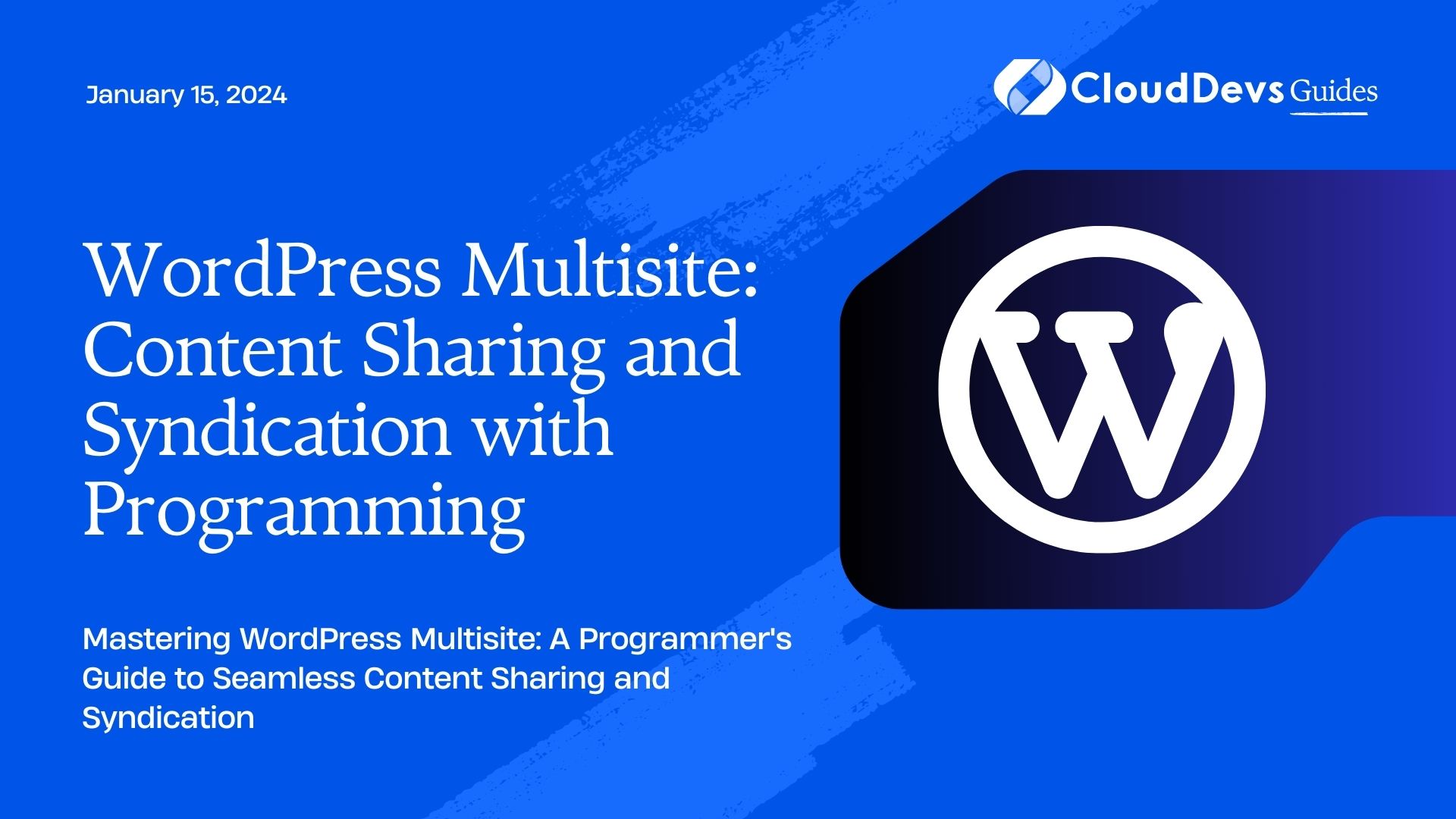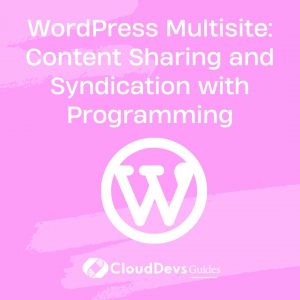WordPress Multisite: Content Sharing and Syndication with Programming
If you’re looking to manage multiple WordPress websites efficiently and share content seamlessly, WordPress Multisite is your go-to solution. Whether you’re a content creator, a business owner, or a developer, this powerful feature can save you time and effort while streamlining your content management process.
Table of Contents
In this comprehensive guide, we will explore WordPress Multisite and dive into how you can use programming to enhance its capabilities for content sharing and syndication. We’ll cover everything from the basics to advanced techniques, including code samples and best practices.
1. What is WordPress Multisite?
1.1. The Basics
WordPress Multisite is a feature that allows you to create and manage multiple WordPress websites from a single installation. It’s like having your own network of interconnected websites, all controlled from a centralized dashboard. Each website in a Multisite network is independent in terms of content and themes but shares the same core installation, plugins, and user management.
1.2. When to Use WordPress Multisite
WordPress Multisite is incredibly versatile and can be used in various scenarios:
- Content Networks: If you run a network of websites with related content, such as news sites, educational institutions, or regional businesses, Multisite can simplify content management.
- Intranets and Extranets: You can create private networks for your organization, enabling team members or clients to access specific websites with ease.
- User Communities: If you’re building a platform where users can create their blogs or websites (think WordPress.com), Multisite can facilitate this setup.
- Microsites: For marketing campaigns or special events, Multisite allows you to quickly spin up new websites with a common theme and design.
- Cost-Efficiency: Managing multiple websites from a single installation can save you hosting costs and reduce maintenance overhead.
Now that you understand the basics let’s move on to programming techniques for optimizing your WordPress Multisite network.
2. Programming WordPress Multisite
2.1. Custom Themes and Plugins
One of the main advantages of WordPress Multisite is that you can manage themes and plugins centrally. However, there may be instances where you want to offer custom themes or plugins for specific sites within your network.
Code Sample: Custom Plugin Activation
php
function custom_plugin_activation() {
if ( get_current_blog_id() == 2 ) {
// Activate custom plugin for site ID 2
activate_plugin( 'custom-plugin/custom-plugin.php' );
}
}
add_action( 'init', 'custom_plugin_activation' );
In the code above, we’re activating a custom plugin for Site ID 2 within the Multisite network. You can customize this code to suit your specific needs.
2.2. Content Syndication
Content syndication involves sharing posts or content across different sites within your Multisite network. This can be useful for sharing news, announcements, or any content that’s relevant to multiple sites.
Code Sample: Content Syndication
php
function syndicate_content( $content ) {
if ( is_main_site() ) {
// Display content only on the main site
return $content;
} else {
// Get content from the main site
$main_site_content = get_content_from_main_site();
return $main_site_content;
}
}
add_filter( 'the_content', 'syndicate_content' );
In this code, we’re filtering the content to display it only on the main site. For sub-sites, we fetch content from the main site and display it instead. This is just a basic example; you can extend this to suit your syndication needs.
2.3. User Management
WordPress Multisite offers robust user management features. You can programmatically add, update, or delete users across all sites in your network.
Code Sample: Add User to All Sites
php
function add_user_to_all_sites( $user_id ) {
$sites = get_sites();
foreach ( $sites as $site ) {
add_user_to_blog( $site->blog_id, $user_id, 'subscriber' );
}
}
add_action( 'user_register', 'add_user_to_all_sites' );
With this code, when a new user registers, they are automatically added as a subscriber to all sites within the Multisite network.
2.4. Centralized Settings
Managing settings across multiple sites can be a daunting task. Programming can help you centralize and control settings efficiently.
Code Sample: Centralized Settings
php
function centralize_settings() {
$settings = array(
'site_title' => 'My Multisite Network',
'posts_per_page' => 10,
);
update_site_option( 'network_settings', $settings );
}
add_action( 'init', 'centralize_settings' );
In this code, we’re centralizing network settings using update_site_option. This allows you to control important settings from a single location.
3. Best Practices for WordPress Multisite with Programming
3.1. Regular Backups
Always perform regular backups of your Multisite network. Use reliable backup plugins or scripts to ensure you can recover your data in case of any issues.
3.2. Testing Environment
Before implementing any significant changes or custom code, create a testing environment. This way, you can test your code without affecting the live network.
3.3. Security Measures
Multisite networks can be attractive targets for hackers due to their interconnected nature. Ensure robust security measures are in place, including strong passwords, security plugins, and monitoring.
3.4. Documentation
Maintain thorough documentation of your network setup, custom code, and configurations. This will be invaluable for troubleshooting and future reference.
3.5. Scalability
Consider the scalability of your network. As it grows, you might need to invest in better hosting, optimize your database, and fine-tune your code for performance.
Conclusion
WordPress Multisite is a powerful tool for managing multiple websites efficiently. By implementing programming techniques, you can take full advantage of its capabilities for content sharing and syndication, user management, and centralized control.
Remember to follow best practices, perform regular maintenance, and keep your network secure to ensure a smooth and successful experience with WordPress Multisite. With the right approach, you can create a network of websites that’s easy to manage, scalable, and tailored to your specific needs.
So, why wait? Start exploring the world of WordPress Multisite with programming today and take your web management to the next level!
Table of Contents








